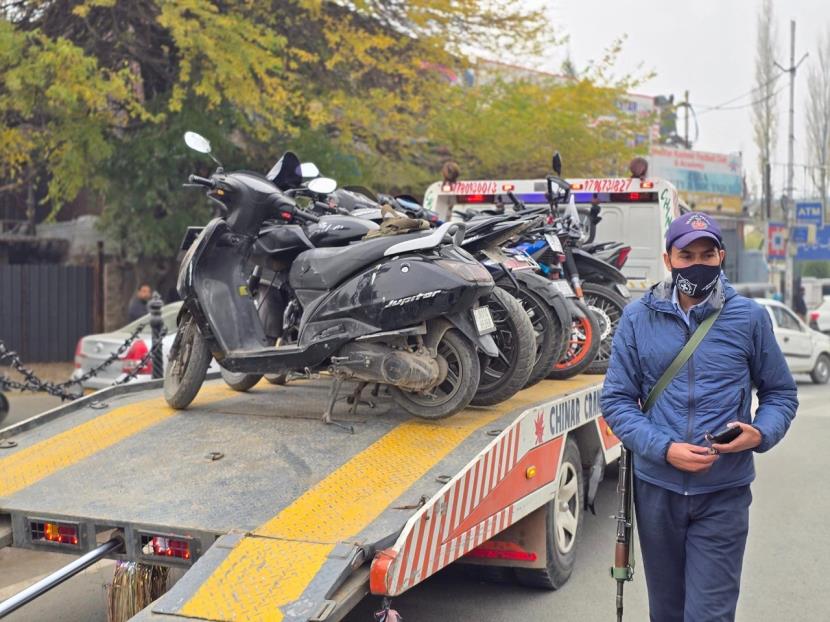Srinagar’s Underage Driving Dilemma: A Wake-Up Call for Action
By: Javid Amin
In Srinagar, a troubling trend has taken hold: elite schools are reportedly turning a blind eye as students aged 16-17 arrive in high-end SUVs, particularly models like the Thar and other luxury vehicles. This phenomenon raises urgent questions about the enforcement of traffic laws, societal attitudes, and the shared responsibility of parents, schools, and authorities to address underage driving.
With the legal age for obtaining a driving license set at 18 in India, this situation not only reflects a blatant disregard for the law but also highlights the potential dangers posed by untrained and underage drivers on the roads. Let’s take a closer look at the multifaceted issue, its implications, and the actions required to combat this growing concern.
The Scope of the Problem: Underage Driving in Srinagar
1. A Cultural and Societal Shift
In recent years, owning and driving high-end SUVs has become a status symbol for many families in Srinagar. For some, allowing their children to drive these vehicles to school is seen as a reflection of affluence and modernity.
This trend, however, comes with serious risks. Underage drivers, lacking proper training and licenses, are ill-equipped to handle the challenges of navigating Srinagar’s busy and often chaotic roads.
2. Fueling the Issue: Lax Petrol Pump Practices
Despite the clear illegality of underage driving, many petrol pumps in the city continue to sell fuel to these young drivers without checking for valid licenses. This lack of scrutiny further enables the trend, putting more underage drivers behind the wheel.
3. Weak Enforcement by Authorities
The role of traffic police in controlling underage driving has come under scrutiny. Critics argue that instead of taking decisive action—such as seizing vehicles or referring cases to juvenile justice boards—authorities are largely turning a blind eye. This enforcement gap exacerbates the problem, creating a perception of impunity.
The Risks of Underage Driving
1. Increased Road Accidents
Inexperienced drivers are more likely to make critical errors, leading to accidents. Studies have shown that young drivers are at higher risk due to their lack of experience, overconfidence, and impulsive decision-making.
2. Threat to Public Safety
Underage driving doesn’t just endanger the drivers themselves—it puts pedestrians, cyclists, and other motorists at significant risk.
3. Legal and Social Consequences
Parents of underage drivers could face legal action, including fines and potential imprisonment, under the Motor Vehicles Act. Moreover, incidents involving underage drivers can lead to strained relations between schools, parents, and the community.
Perspectives on Underage Driving
Parents
- Positive: Some parents believe allowing their children to drive instills responsibility and independence.
- Negative: Others worry about their child’s safety and recognize the legal and ethical implications of underage driving.
Teachers and Schools
- Positive: Teachers emphasize the importance of parental involvement in curbing such behavior.
- Negative: Schools often lack policies to monitor and discourage underage driving among students.
Traffic Police and Authorities
- Positive: Officials stress that public cooperation is essential for effective law enforcement.
- Negative: Weak enforcement and inadequate resources hinder their ability to tackle the issue effectively.
The General Public
- Positive: Many citizens advocate for stricter rules and community awareness campaigns.
- Negative: Others express frustration over the lack of accountability among affluent families.
Teenagers Themselves
- Positive: Teens see driving as a symbol of freedom and status.
- Negative: Few realize the gravity of the risks involved until it’s too late.
Addressing the Issue: A Collaborative Approach
1. Parental Responsibility
Parents play a crucial role in shaping their children’s attitudes toward road safety and the law.
- Open conversations about the risks and legal implications of underage driving are essential.
- Set an example by following traffic rules and fostering respect for the law.
2. Role of Schools
Schools must take a proactive stance to discourage underage driving.
- Introduce policies prohibiting students from driving to school without valid licenses.
- Conduct regular awareness sessions on road safety and the dangers of underage driving.
3. Strengthening Law Enforcement
Traffic police and other authorities need to adopt a zero-tolerance approach to underage driving.
- Increase checkpoints near schools to verify licenses and impound vehicles driven by underage individuals.
- Collaborate with schools to identify and penalize offenders.
4. Petrol Pump Accountability
Fuel stations should implement strict protocols to ensure fuel is sold only to licensed drivers.
- Install signage emphasizing the legal requirements for purchasing fuel.
- Train staff to verify licenses before completing fuel sales.
5. Public Awareness Campaigns
Widespread campaigns can educate the community on the risks and consequences of underage driving.
- Utilize social media, local news outlets, and schools to amplify the message.
- Partner with NGOs and traffic safety organizations to organize workshops and seminars.
A Path Forward: Ensuring Safer Roads in Srinagar
The issue of underage driving in Srinagar is not insurmountable. With a concerted effort from parents, schools, authorities, and the community, meaningful change can be achieved.
Immediate Actions to Consider
- Launch a dedicated helpline for reporting underage drivers.
- Encourage schools to reward students who demonstrate responsible behavior.
- Use local influencers and public figures to advocate for safe driving practices.
Long-Term Solutions
- Invest in advanced traffic monitoring systems to improve enforcement.
- Introduce mandatory road safety education in school curriculums.
- Establish a task force to regularly review and address traffic law violations.
Join the Movement for Safer Roads
This is not just a call for stricter rules; it’s a call for cultural change. Let’s prioritize the safety of our children and communities by addressing the root causes of underage driving.
What You Can Do:
- Parents: Commit to keeping your children safe and law-abiding.
- Schools: Foster a culture of responsibility and awareness.
- Citizens: Report violations and support enforcement efforts.
Together, we can create safer roads and a more responsible future for Srinagar. Let’s act now before it’s too late.


